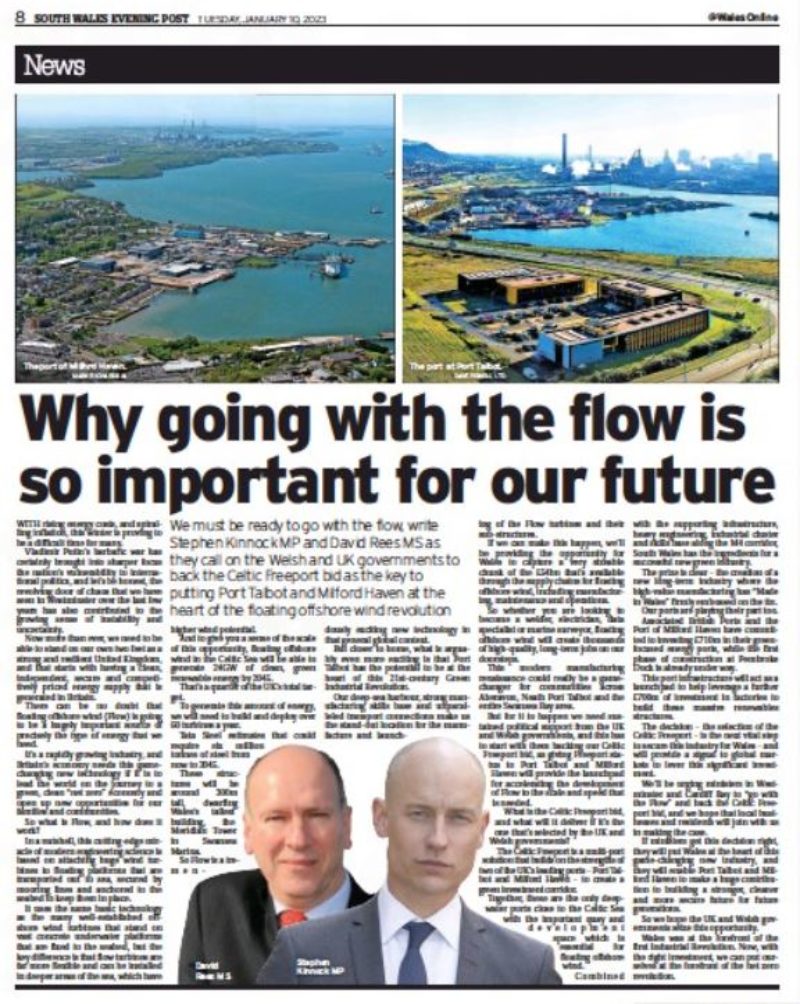
South Wales Evening Post
We must be ready to go with the FLOW, writes Stephen Kinnock MP and David Rees MS as they call on the Welsh and UK governments to back the Celtic Freeport bid, as the key to putting Port Talbot and Milford Haven at the heart of the Floating Off-shore Wind revolution
With rising energy costs, and spiralling inflation, this winter is proving to be a difficult time for many.
Putin’s barbaric war has certainly brought into sharper focus the nation’s vulnerability to international politics, and let’s be honest the revolving door of chaos that we have seen in Westminster over the last few years has also contributed to the growing sense of instability and uncertainty.
Now more than ever we need to be able to stand on our own two feet as a strong and resilient United Kingdom, and that starts with having a clean, independent, secure and competitively priced energy supply that is generated in Britain.
There can be no doubt that floating off-shore wind (FLOW) is going to be a hugely important source of precisely the type of energy that we need. It’s a rapidly growing industry, and Britain’s economy needs this game-changing new technology if it is to lead the world on the journey to a green, clean ‘net zero’ economy and open up new opportunities for our families and communities.
So what is FLOW, and how does it work?
In a nutshell, this cutting-edge miracle of modern engineering science is based on attaching huge wind turbines to floating platforms that are transported out to sea, secured by mooring lines and anchored to the seabed to keep them in place.
It uses the same basic technology as the many well established off-shore wind turbines that stand on vast concrete underwater platforms that are fixed to the seabed, but the key difference is that FLOW turbines are far more flexible and can be installed in deeper areas of the sea, which have higher wind potential.
And to give you a sense of the scale of this opportunity, floating offshore wind in the Celtic Sea will be able to generate 24GW of clean, green renewable energy by 2045.
That’s one-quarter of the UK’s total target.
To generate this amount of energy, we will need to build and deploy over 60 turbines a year.
Tata Steel estimate that could require six million tonnes of steel from now to 2045.
These structures will be around 300 metres tall – dwarfing Wales’ tallest building, the Meridian Tower in Swansea.
So FLOW is a tremendously exciting new technology in that general global context.
But closer to home, what is arguably even more exciting is that Port Talbot has the potential to be at the heart of this twenty-first century Green Industrial Revolution.
Our deep-sea harbour, strong manufacturing skills base and unparalleled transport connections make us the stand-out location for the manufacture and launching of the FLOW turbines and their sub-structures.
If we can make this happen we’ll be providing the opportunity for Wales to capture a very sizeable chunk of the £54 billion that’s available through the supply chains for floating offshore wind, including manufacturing, maintenance and operations.
So whether you are looking to become a welder, electrician, data specialist or marine surveyor, floating offshore wind will create thousands of high-quality, long-term jobs on our doorsteps.
This modern manufacturing renaissance could really be a game-changer for communities across Aberavon, Neath Port Talbot and the entire Swansea Bay area.
But for it to happen we need sustained political support from the UK and Welsh governments, and this has to start with them backing our Celtic Freeport bid, as giving Freeport status to Port Talbot and Milford Haven will provide the launch pad for accelerating the development of FLOW to the scale and speed that is needed.
What is the Celtic Freeport bid, and what will it deliver if it’s the one that’s selected by the UK and Welsh governments?
The Celtic Freeport is a multi-port solution that builds on the strengths of two of the UK’s leading ports – Port Talbot and Milford Haven – to create a green investment corridor.
Together, these are the only deep-water ports close to the Celtic Sea with the important quay and development space which is essential for floating offshore wind.
Combined with the supporting infrastructure, heavy engineering, industrial cluster and skills base along the M4 corridor, south Wales has the ingredients for a successful new green industry.
The prize is clear: the creation of a new long-term industry where the high-value manufacturing has “Made in Wales” firmly embossed on the tin.
Our ports are playing their part too.
Associated British Ports and the Port of Milford Haven have committed to invest £710 million in their green focused energy ports, while the first phase of construction at Pembroke Dock is already underway.
This port infrastructure will act as a launch-pad to help leverage a further £700 million of investment in factories to build these massive renewables structures.
The decision – the selection of the Celtic Freeport – is the next vital step to secure this industry for Wales – and will provide a signal to global markets to lever this significant investment.
We’ll be urging ministers in Westminster and Cardiff Bay to go with the FLOW and back the Celtic Freeport bid, and we hope that local businesses and residents will join with us in making the case.
If ministers get this decision right they will put Wales at the heart of this game-changing new industry, and they will enable Port Talbot and Milford Haven to make a huge contribution to building a stronger, cleaner and more secure future for future generations.
So we hope the UK and Welsh Governments seize this opportunity.
Wales was at the forefront of the first industrial revolution. Now, with the right investment, we can put ourselves at the forefront of the net zero revolution.

